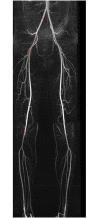Reference values of vessel diameters, stenosis prevalence, and arterial variations of the lower limb arteries in a male population sample using contrast-enhanced MR angiography
- PMID: 29924802
- PMCID: PMC6010244
- DOI: 10.1371/journal.pone.0197559
Reference values of vessel diameters, stenosis prevalence, and arterial variations of the lower limb arteries in a male population sample using contrast-enhanced MR angiography
Abstract
Introduction: Morphological characterization of leg arteries is of significant importance to detect vascular remodeling triggered by atherosclerotic changes. We determined reference values of vessel diameters and assessed prevalence of stenosis and arterial variations of the lower limb arteries in a healthy male population sample.
Methods: Gadolinium-enhanced magnetic resonance angiography at 1.5 Tesla was performed in 756 male participants (median age = 52 years, range = 21-82 years) of the population-based Study of Health in Pomerania. Vessel diameters were measured in 9 predefined segments of the pelvic and leg arteries and 95th percentiles were used for upper reference values of means of left and right side arteries.
Results: Reference values of vascular diameters decreased from proximal to distal arteries: common iliac = 1.18cm; internal iliac = 0.75cm; external iliac = 1.03cm; proximal femoral = 1.02cm; distal femoral = 0.77cm; popliteal = 0.69cm; anterior tibial = 0.42cm; posterior tibial = 0.38cm; fibular = 0.40cm. Body-surface area indexed reference values increased with age in all segments. A number of 53 subjects (7.0%) had at least one stenosis, mainly in the lower leg arteries anterior tibial (n = 28, 3.7%), posterior tibial (n = 18, 2.4%) and fibular (n = 20, 2.6%). The risk of stenosis increased considerably with age (odds ratio = 1.08; p<0.001). The most common arterial variant was type I-A in both legs (n = 620, 82%).
Conclusion: We present reference values for different pelvic and leg artery segment diameters in men that decrease from proximal to distal and increase with age. Stenoses were most prevalent in lower leg arteries and type I-A was the most common variant in the lower leg.
Conflict of interest statement
The authors have declared that no competing interests exist.
Figures


Similar articles
-
Clinical utility of time-resolved imaging of contrast kinetics (TRICKS) magnetic resonance angiography for infrageniculate arterial occlusive disease.J Vasc Surg. 2007 Mar;45(3):543-8; discussion 548. doi: 10.1016/j.jvs.2006.11.045. Epub 2007 Jan 16. J Vasc Surg. 2007. PMID: 17223303
-
Intraarterial MR angiography and DSA in patients with peripheral arterial occlusive disease: prospective comparison.Radiology. 2006 Jun;239(3):901-8. doi: 10.1148/radiol.2393041574. Epub 2006 Apr 26. Radiology. 2006. PMID: 16641335
-
Lower extremity artery stenosis distribution in an unselected elderly population and its relation to a reduced ankle-brachial index.J Vasc Surg. 2009 Aug;50(2):330-4. doi: 10.1016/j.jvs.2009.03.008. Epub 2009 May 15. J Vasc Surg. 2009. PMID: 19446989
-
Understanding the Arterial Anatomy and Dermal Perfusion of the Lower Extremity with Clinical Application.Clin Podiatr Med Surg. 2020 Oct;37(4):743-749. doi: 10.1016/j.cpm.2020.07.003. Epub 2020 Aug 13. Clin Podiatr Med Surg. 2020. PMID: 32919601 Review.
-
Arteries of the Lower Limb-Embryology, Variations, and Clinical Significance.Can Assoc Radiol J. 2022 Feb;73(1):259-270. doi: 10.1177/08465371211003860. Epub 2021 Apr 22. Can Assoc Radiol J. 2022. PMID: 33886403 Review.
Cited by
-
Ultrasound-guided arterial catheterization.Anesth Pain Med (Seoul). 2021 Apr;16(2):119-132. doi: 10.17085/apm.21012. Epub 2021 Apr 15. Anesth Pain Med (Seoul). 2021. PMID: 33866769 Free PMC article. Review.
-
A Randomized Trial to Compare Ultrasound-Guided Dorsalis Pedis Versus Posterior Tibial Artery Cannulation in Neurosurgical Patients.Cureus. 2023 Jan 8;15(1):e33514. doi: 10.7759/cureus.33514. eCollection 2023 Jan. Cureus. 2023. PMID: 36779138 Free PMC article.
-
Optimized design of an arterial network model reproduces characteristic central and peripheral haemodynamic waveform features of young adults.J Physiol. 2022 Aug;600(16):3725-3747. doi: 10.1113/JP282942. Epub 2022 Aug 2. J Physiol. 2022. PMID: 35852442 Free PMC article.
-
Gluteal ischemic gangrene due to chronic aortoiliac occlusive disease.J Vasc Surg Cases Innov Tech. 2025 Mar 31;11(4):101792. doi: 10.1016/j.jvscit.2025.101792. eCollection 2025 Aug. J Vasc Surg Cases Innov Tech. 2025. PMID: 40386550 Free PMC article.
-
Analysis of the Common Femoral Artery and Vein: Anatomical Morphology, Vessel Relationship, and Factors Affecting Vessel Size.Medicina (Kaunas). 2022 Feb 21;58(2):325. doi: 10.3390/medicina58020325. Medicina (Kaunas). 2022. PMID: 35208648 Free PMC article.
References
-
- Diehm C, Allenberg JR, Pittrow D, Mahn M, Tepohl G, Haberl RL, et al. (2009) Mortality and vascular morbidity in older adults with asymptomatic versus symptomatic peripheral artery disease. Circulation 120: 2053–2061. doi: 10.1161/CIRCULATIONAHA.109.865600 - DOI - PubMed
-
- Jensen SA, Vatten LJ, Nilsen TI, Romundstad PR, Myhre HO (2005) The association between smoking and the prevalence of intermittent claudication. Vasc Med 10: 257–263. doi: 10.1191/1358863x05vm635oa - DOI - PubMed
-
- Jensen SA, Vatten LJ, Myhre HO (2008) The association between diabetes mellitus and the prevalence of intermittent claudication: the HUNT study. Vasc Med 13: 239–244. - PubMed
-
- Golledge J, Leicht A, Crowther RG, Clancy P, Spinks WL, Quigley F (2007) Association of obesity and metabolic syndrome with the severity and outcome of intermittent claudication. J Vasc Surg 45: 40–46. doi: 10.1016/j.jvs.2006.09.006 - DOI - PubMed
-
- Kieback AG, Lorbeer R, Wallaschofski H, Ittermann T, Volzke H, Felix S, et al. (2012) Claudication, in contrast to angina pectoris, independently predicts mortality risk in the general population. Vasa 41: 105–113. doi: 10.1024/0301-1526/a000172 - DOI - PubMed
Publication types
MeSH terms
Substances
LinkOut - more resources
Full Text Sources
Other Literature Sources

